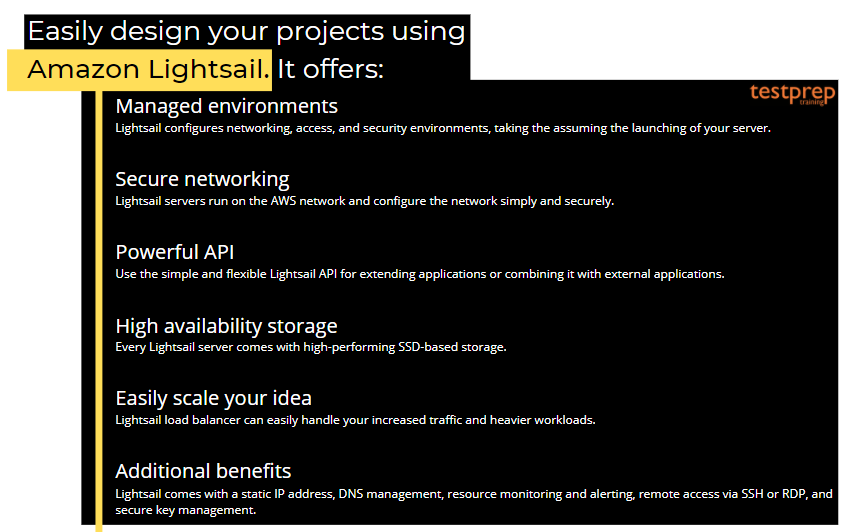By providing a Virtual Private Server (VPS) for a reasonable price, Amazon Lightsail helps in managing everything required for building applications or websites for a cost-effective, monthly plan. This service is best suitable for both beginners and advanced who have started or are already on their path to get more advanced in the cloud using AWS infrastructure.
But, what exactly Lightsail is, and how we can get started with this? To answer this, in this blog, we will learn and cover in-depth details of Amazon Lightsail and the steps to enter into this area. So, let’s start with a quick overview.
What is Amazon Lightsail: Virtual Private Server (VPS)?
Amazon Lightsail: Virtual Private Server (VPS) can be considered as the simplest way for getting into the Amazon Web Services (AWS) for creating websites or applications. This covers instances (virtual private servers), container services, SSD-based block storage, static IP addresses, managed databases, DNS management of registered domains, content delivery network (CDN) distributions, load balancers, and resource snapshots (backups) in a very effective and low price.
Further, the Lightsail is designed for developers in which they can select the image for dev projects without any need for spending time installing software or frameworks. This also helps in deploying and controlling basic cloud resources by providing you access to,
- Firstly, images with base operating systems
- Secondly, development stacks such as LAMP, LEMP (Nginx), and SQL Server Express
- Lastly, applications such as WordPress, Drupal, and Magento.
Uses of Amazon Lightsail: Virtual Private Server (VPS)
Lightsail is suitable for workloads, fast deployments, and beginning with AWS. This helps in starting small, and then scale as you grow. Uses include:
- Lightsail helps in deploying a web application in just a few clicks. This uses pre-configured development stacks such as LAMP, Nginx, MEAN, and Node.js.
- Using Lightsail you can,
- Firstly, build a website that shines
- Secondly, pre-configured applications such as WordPress, Magento, Plesk, and Joomla for modifying blogs, e-commerce, or personal website.
- This helps in running open-source and commercial software for your business. Moreover, you can quickly launch your line-of-business software such as,
- file storage and sharing
- backups, financial and accounting software, and more.
- Lastly, Lightsail helps developers in easily creating dev sandboxes and testing environments outside the prod environment. Moreover, this can test without the concern of breaking something and then provide the option to destroy them.

What are the features of Amazon Lightsail?
Amazon Lightsail comes with unique features planned for making the projects quickly come to life. Some of the top-most features include:
1. Lightsail virtual servers
Lightsail provides virtual servers (instances) for easily configuring and backing the AWS power and reliability. This can help in getting started with your website, web application, or project including controlling instances from the in-built Lightsail console or API.
Further, while cheating instance, Lightsail enables you click-to-launch a simple operating system (OS), a pre-configured application, or development stacks like WordPress, Windows, Plesk, LAMP, Nginx, and more. Moreover, every Lightsail instance contains a built-in firewall that provides access to allow or restrict traffic to your instances depending on source IP, port, and protocol. And, once instance starts running you can build custom alarms and get notifications alerts for every action.
2. Object storage
Lightsail provides options for storing static content like images, videos, or HTML files in object storage. This is can be used for your websites and applications. Further, Lightsail object storage can be linked with Lightsail CDN distribution in just a few clicks and provides fast and enhance content delivery to a global audience.
3. Simplified load balancing
Lightsail’s simplified load balancing directs web traffic over instances so that websites and applications can,
- Firstly, accommodate variations in traffic
- Secondly, stay protected from outages
- Lastly, deliver a smooth experience to visitors.
Further, Lightsail load balancers provide free SSL/TLS certificates using combined certificate management. This can be provisioned and easily added to a load balancer for requesting and controlling manage certificates from the Lightsail console.
4. Managed databases
Lightsail managed databases help in easily scaling databases independently of your virtual servers, enhance the availability of your applications, or run standalone databases in the cloud. Moreover, it enables you to deploy multi-tiered applications inside the Lightsail by generating multiple instances connected to a centrally managed database, and a load balancer controlling traffic to the instances.
5. Containers
Lightsail provides a simple way to running containers in the cloud. Moreover, the customers can now run containerized applications and securely access them from the internet using the Lightsail Container Service. Furthermore, this service also allows customers for running docker containers on the cloud from developer workflows.
6. Upgrading to EC2
In Lightsail you get the option to easily move to EC2 with a simple, guided experience. Moreover, for this feature, Lightsail provides comfort while expanding your website or application by scaling it as per the requirements.
Further, for upgrading, take a snapshot of your instance and then, follow the step-by-step process in the Lightsail console for exporting your snapshot to EC2.
7. Accessing AWS services
You can easily begin with Amazon Lightsail by using a fixed set of features such as instances, managed databases, and load balancers. Moreover, you can also combine your Lightsail project with some of the 90+ other services in AWS via Amazon VPC peering.
Click-to-launch OS & applications
Lightsail provides access to preconfigured, one-click-to-launch operating systems, development stacks, and web applications, including:
Amazon Lightsail pricing:
Currently, Lightsail is providing various offers on its pricing. This includes:
- Firstly, three months free on Linux/Unix bundles:
- $3.50 USD/month
- $5 USD/month
- $10 USD/month
- Secondly, three months free on Windows bundles:
- $8 USD /month
- $12 USD/month
- $20 USD/month
- Thirdly, three months free on the $15 USD/month Database bundle
- Then, three months free on the $10 USD/month Container service (Micro -1 node)
- Lastly, 12 months on CDN
Now that we have understood the basics and features of Amazon Lightsail, it’s time to get started with this service.
Getting started with Amazon Lightsail: Virtual Private Server (VPS)
The best way to start understanding Lightsail is to learning and covering its core areas. Some of them are:
 Virtual Server
Virtual Server
For easily launching an instance (or virtual server) in few clicks.
The virtual server covers various tasks, one of them is to staring using Windows Server-based instances in Lightsail. That is to say, you can start creating Lightsail instances running the Windows Server operating system (OS). However, there are three OS blueprints available:
- Windows Server 2019
- Then, Windows Server 2016 R2
- Windows Server 2012 R2.
 Managed Databases
Managed Databases
Quickly launching a fully configured MySQL or PostgreSQL database.
Using the managed database you can quickly generate MySQL or PostgreSQL managed database in Amazon Lightsail. Moreover, the Lightsail makes database administration more efficient by controlling the common maintenance and security tasks. Using the Lightsail console, you can:
- Firstly, back up your database to a snapshot.
- Secondly, build a new larger database from a snapshot.
- Thirdly, troubleshoot common issues with browser-based logs and metrics.
- Lastly, recover data by using point-in-time backup and restore operations.
 Load Balancers
Load Balancers
Distributing traffic over multiple instances for handling variations.
A Lightsail load balancer helps in distributing the incoming web traffic among multiple Lightsail instances, in multiple Availability Zones. Load balancing expands the availability and fault tolerance of the application on your instances. Further, you can also add and remove instances from your Lightsail load balancer according to the requirements.
 Block storage disks
Block storage disks
Scaling your storage fastly with SSD-backed storage.
Block storage can be considered as a storage architecture that controls data as “blocks”. However, every storage block is known as a “disk” in Lightsail that behaves like an individual hard disk that you can link to your server. In simple words, you can use additional block storage for applications or software that must separate out definite data from their core service, and for protecting application data in case of a failure or other issue using instance and boot storage disk.
Further, this provides solid-state drives (SSD) for block storage. This can be referred to as a type of block storage balance for providing better performance at a reasonable price. This helps in supporting the huge majority of workloads that run on Lightsail.
Final Words
By providing solutions to top projects like Windows Server and WordPress, Amazon Lightsail has created trust amongst many other customers. This service is all set to provide virtual private servers at reasonable prices so that every company can take benefits from this. So, if you have an interest in getting starting with this service, go through the above information provided and checks for your requirements, and then start using this.
Prepare for the AWS SOA-C02 exam and become Certified Professional Now!




 Virtual Server
Virtual Server Managed Databases
Managed Databases Load Balancers
Load Balancers Block storage disks
Block storage disks